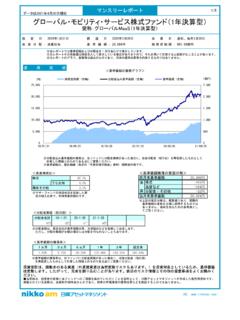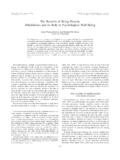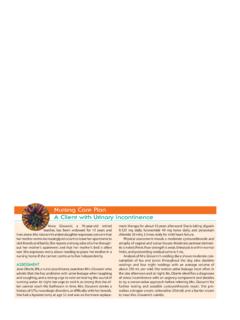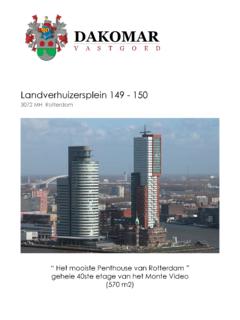Transcription of Injectable Fillers: Review of Material and Properties
1 29. Injectable fillers : Review of Material and Properties Natalie Huang Attenello, MD2 Corey S. maas , MD, FACS1,2. 1 Department of Facial Plastic and Reconstructive Surgery, University Address for correspondence Corey S. maas , The maas Clinic, 2400 Clay of California, San Francisco, California Street, San Francisco, CA 94115 (e-mail: 2 Department of Aesthetic and Facial Plastic Surgery, The maas Clinic, San Francisco, California Facial Plast Surg 2015;31:29 34. This document was downloaded for personal use only. Unauthorized distribution is strictly prohibited. Abstract With an increasing understanding of the aging process and the rapidly growing interest in minimally invasive treatments, Injectable facial llers have changed the perspective for the treatment and rejuvenation of the aging face. Other than autologous fat and certain preformed implants, the collagen family products were the only Food and Drug Administration approved soft tissue llers.)
2 But the overwhelming interest in soft tissue Keywords llers had led to the increase in research and development of other products including soft tissue llers bioengineered nonpermanent implants and permanent alloplastic implants. As multiple hyaluronic acid Injectable soft tissue llers and biostimulators are continuously becoming available, it is calcium important to understand the biophysical Properties inherent in each, as these constitute hydroxylapatite the clinical characteristics of the product. This article will Review the materials and poly-L-lactic acid Properties of the currently available soft tissue llers: hyaluronic acid, calcium polymethyl- hydroxylapatite, poly-L-lactic acid, polymethylmethacrylate, and autologous fat (and methacrylate aspirated tissue including stem cells). Minimally invasive procedures have revolutionized the Historical Background treatment paradigm for facial rejuvenation and may very well be one of the most signi cant changes in the recent The utility of facial llers traces back to the 19th century history for facial plastic surgery.
3 Initially utilized for the when autologous fat was rst described as a soft tissue ller treatment of ne lines and wrinkles, the concept of llers for cosmetic deformity by the German physician, Dr. Franz has expanded to include correction of volume loss and This was later replaced by paraf n in the early 1900s augmentation of the aging face. Since bovine collagen was but was soon abandoned after reports of embolization, introduced as the rst Injectable ller in the early 1970s, granuloma formation, and In the mid-20th cen- several other products have been developed for soft tissue tury, a shift was seen toward puri ed synthetic polymers in augmentation ranging from both synthetic materials to the form of Injectable silicone. Although seemingly promising autologous tissue. The ideal soft tissue ller is one that is at rst, the Food and Drug Administration (FDA) eventually effective, nonimmunogenic, nontoxic, noncarcinogenic, banned this for similar complications of granuloma forma- nonmigratory, easily applied, nonpalpable, painless, and Although, microdroplet injection of limited amounts of long Currently available Injectable llers can be silicone Material is still used today as an off-label use for broadly classi ed into the following three different catego- silicone that is FDA approved for ocular 7 Te on, a ries: hyaluronic acid (HA) derivatives, synthetic llers, and synthetic polytetra uoroethylene polymer, was next tested autologous fat.
4 This article reviews the varying Properties as a soft tissue ller, but it was quickly abandoned because of and materials inherent in the currently available Injectable the in ammatory reaction and injection dif culty that was llers ( Table 1). Until the early 1980s, none of the previously Issue Theme Management of Facial Copyright 2015 by Thieme Medical DOI Volume; Guest Editors, Edward D. Publishers, Inc., 333 Seventh Avenue, Buckingham, MD, and Mark Glasgold, MD New York, NY 10001, USA. ISSN 0736-6825. Tel: +1(212) 584-4662. 30 Injectable fillers Attenello, maas Table 1 Comparison of soft tissue llers Filler Manufacturer Composition Needle size Depth Hyaluronic acid Restylane Galderma, Ft. 20 mg/mL hyaluronic 29 30 gauge Mid-to-deep dermis Worth, TX acid; 400 m particle size Perlane Galderma, Ft. 20 mg/mL hyaluronic 27 29 gauge Deep dermis, Worth, TX acid; 750 1,000 m super cial subcutis particle size Juv derm XC Allergan, Inc, 24 mg/mL with 27 gauge Mid-to-deep dermis Irvine, CA lidocaine Juv derm Voluma Allergan, Inc, 20 mg/mL with 27 gauge Deep (subcutane- Irvine, CA lidocaine ous, supraperiosteal).
5 This document was downloaded for personal use only. Unauthorized distribution is strictly prohibited. Belotero Merz North America, mg/mL 30 gauge Mid-to-deep dermis Greensboro, NC. Synthetic llers Radiesse BioForm Medical, San 30% calcium hydroxyl- 25 27 gauge Subdermal Mateo, CA apatite microspheres/. 70% carrier gel Sculptra Dermik Laboratories, mg powder of 26 gauge Deep dermis Berwyn, PA poly-L-lactic acid microspheres ArteFill Suneva Medical, San 20% polymethylme- 26 gauge Dermal subdermal Diego, CA thacrylate suspended junction in 80% solution with bovine collagen and lidocaine Autologous fat Autologous fat Autologous Liposuctioned fat 18 gauge nee- Subcutaneous dle with blunt cannula attempted facial llers had received FDA approval until the mechanical Properties such as gel rmness and half-life of bovine collagen, Zyderm (Inamed Corp., Santa Barbara, CA) the HA product ( Figs. 1 and 2).
6 11,15 The different composi- was approved in 1981. The approval of Zyderm led to tions of the chemically modi ed HA llers are at the discre- widespread research and development of other llers includ- tion of the manufacturer and thus create variations amongst ing alloplastic and implantable materials as well as the the HA products as llers. renewed interest and utilization of autologous Even The concentration of HA in the ller differs with each with an increase in research, though, bovine collagen was manufacturer and is typically listed as the total amount of HA. the only FDA approved ller for the next two decades until (soluble and insoluble HA, mg/mL) found in the It is 2003 when the FDA approved the rst HA dermal ller important to understand that only the cross-linked HA, or the (Restylane; Galderma, Ft. Worth, TX). Since this approval, more insoluble HA, functions as the dermal ller by resisting the last decade has seen a dramatic increase in the number of degradation and providing more longevity in the dermis.
7 The FDA approved facial llers in response to the growing popu- listed soluble-free HA, or unmodi ed HA, are usually by- larity of minimally invasive facial rejuvenation procedures. products of their chemical modi cations and will quickly be Over 2 million soft tissue ller procedures were performed in metabolized given their solubility. the United States in Most HAs are viscoelastic and this is measured with the complex modulus, which is the sum of the elastic modulus (G ) with the viscous modulus (G ). The elastic modulus (G ) is Hyaluronic Acid Derivatives used most commonly to characterize the rmness of the gel HA is a naturally occurring glycosaminoglycans composed of and measures the resistance of a Material to deformation the D-glucuronic acid and N-acetyl-D-glucosamine found in the stiffer the Material then the higher the G .12,16 This is deter- dermis. At physiologic pH, HA has excellent biocompatibility mined by the degree and strength of interaction in the cross- as it is anionic and thus binds to water extensively where 1 g linking HA as well as the HA concentration.
8 Clinically, this HA can bind up to 6 L Because of this intrinsic becomes important because gels with a higher G will have solubility, although, it is rapidly cleared when injected into better resistance to the dynamic forces incurred with facial the normal skin a characteristic that should be carefully muscle movement providing long lasting support and volu- controlled if utilized as a dermal 14 Therefore, chemi- mization, this is ideal for areas such as the nasolabial folds and cal modi cation to the carboxyl acid group, and cross-linking marionette One should be cognizant, although, that with dialdehydes and disul des, was necessary to change its gels with a higher G can cause visible small blue papules or Facial Plastic Surgery Vol. 31 No. 1/2015. Injectable fillers Attenello, maas 31. This document was downloaded for personal use only. Unauthorized distribution is strictly prohibited. Fig.
9 1 Cross-linking schematic of hyaluronic acid. (Courtesy of Galderma, Ft. Worth, TX.). nodules (Tyndall effect) if injected super cially in the The particle size and the range of distribution of particle ,18 In contrast, in areas that are more static or with size are another important component for the composition of super cial wrinkles, resistance to deformation by muscle HA gels as this will in uence the extrusion force needed for movement is less critical and gels with lower G are better injection. A larger gel particle will be more dif cult to inject utilized. These gels are also better suited for areas that need through a small bore needle and a more narrow range of more softness, such as the Although all HA gels vary in distribution of particle size can decrease interruptions in the elastic modulus, even the ones with the highest G are much ow of particle extrusion, as uniformity is ideal to provide softer than the elastic modulus of human dermis, which has better control of gel The G also affects the ability G in the 3-MPa ,19 to inject the product through a small bore needle as rm gels Swelling varies among products and manufacturers and with a higher resistance to deformation must be sized as a can partially be attributed to the molecular characteristic of smaller particle and have a narrow particle size range to HA the concentration, amount of cross-linking, and the facilitate particle extrusion.
10 Whereas softer gels with a low products used to hydrate the A gel that is fully hydrated G can have a broader range of particle size because these gels will not swell any further upon injection into the dermis as can be easily deformed as they pass through the they have already reached their hydration capacity. Converse- A unique characteristic of HA is its reversibility via enzy- ly, nonequilibrium gels have a tendency to swell after injec- matic digestion with injection of This natu- tion and thus one must consider under lling when using rally occurring enzyme is FDA approved as a temporary drug these types of dispersion agent by cleaving HA between C1 of an N-acetyl- glucosamine moiety and C4 of a glucuronic acid Thus, its function as a reversal agent for HA is actually off- label, but it has been utilized commonly for reversal of HA. llers. Because of the varying biochemical compositions of the different HA products, it should be noted that each product may respond differently to Distributed by the same manufacturer, both Restylane and Perlane (Galderma, Ft.)





